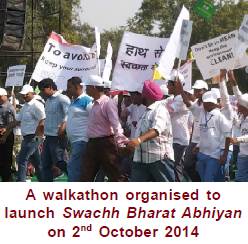|
The Swachh Bharat Abhiyan
in India: T he Swachh Bharat Abhiyan (Clean India Mission), launched on 2nd October 2014, marks the beginning of the largest programme on cleanliness and sanitation by the Government of India till date. The programme aims to accelerate construction of toilets, solid and liquid waste disposal systems; promotion of village cleanliness and provision of adequate drinking water supply to every person by 2019, three years ahead of the deadline set by Nirmal Bharat Abhiyan1 (NBA).NBA will be re-structured into the Swachh Bharat Mission with two sub-missions - Swachh Bharat Mission (Gramin/ Rural) and Swachh Bharat Mission (Urban). The two missions will fall under the Union Ministry of Drinking Water and Sanitation (for Rural India) and the Union Ministry of Urban Development (for Urban India) 2. Funding for these new initiatives will be through budgetary allocations, contributions to the Swachh Bharat Kosh and through commitments under Corporate Social Responsibility (CSR). The proposal is for setting up of a Special Purpose Vehicle within the Mission as a Company under the Company’s Act. It will raise funds from government and non-government sources, including CSR funds. Public Private Partnerships (PPP) are also envisaged for the construction of Community Sanitary Complexes (CSCs).
Swachh Bharat Abhiyan is shaped by the following guiding principles 3:• To eliminate open defecation • To eradicate manual scavenging • To bring about a behavioural change through awareness regarding healthy sanitation practices and its linkages with public health • To strengthen urban local bodies to design, execute and operate systems by increasing involvement of the private sector However, it would also be pertinent to reflect on some of the challenges that may hinder effective implementation of the programme and attainment of the goals envisaged. The reduction in budget of the Information Education and Communication (IEC) component which is critical to trigger behavioural change to ensure usage of toilets is a matter of concern. Co-operation and convergence of all Ministries, Central and State government schemes, CSR and bilateral/multilateral assistance is crucial for the success of the Swachh Bharat Abhiyan. Government schemes such as Mahatma Gandhi National Rural Employment Guarantee Act (MGNREGA), Indira Awaas Yojana for construction of Individual Household Latrines (IHHL), Backward Regions Grant Fund Programme (BRGF) for construction of Community Sanitary Complexes (CSCs) should be converged with the National Rural Drinking Water Programme (NRDWP) to ensure simultaneous water supply to IHHLs, schools and anganwadi4 toilets and CSCs5. The activities under these components have to be ‘area specific’, ‘community specific’ and should also involve all sections of the rural population. Information Education and Communication strategy and plan should be focused on creation of demand leading to behaviour change which in turn would lead to construction and use of the toilets in a sustained manner. Initially the focus should be on triggering of community action for provision of toilet access to every household. Once the toilets are put in place, the focus should start including sustained use as a crucial intervention. Implementation of the Swachh Bharat Mission (SBM) requires large scale social mobilisation at the National/State/District/Block/Village level. Non-government organisations (NGOs) can play a catalytic role in the implementation of SBM in the rural and urban areas. They can be actively involved in the IEC activities, specifically in creating demand, construction and sustained use of the toilets and community level capacity building. Ownership from stakeholders such as block programme management units, gram panchayat (village council level) water and sanitation committees, Swachhata Doots (Cleanliness Ambassadors) and Ministry of Drinking Water and Sanitation (MDWS6) will be the final pieces in completing the jigsaw puzzle for successful implementation of the Swachh Bharat Mission. q Sanghamitra Misra Endnotes 1 Nirmal Bharat Abhiyan (NBA) previously called the Total Sanitation campaign (TSC) is a Community-led total sanitation programme initiated by the Government of India in 1999. It is demand-driven and people-centred. 2 Ministry of Urban Development: http://moud.gov.in/SwachchBharat 3 http://www.narendramodi.in/pm-launches-swachh-bharat-abhiyaan/ 4 Anganwadi is a government sponsored child-care and mother-care centre in India. It caters to children in the 0-6 age group. 5 http://www.indiaenvironmentportal.org.in/files/file/guidelines_Swachh_Bharat_ Mission_Gramin.pdf 6 http://sbm.gov.in/tsc/NBA/NBAHome.aspx
|